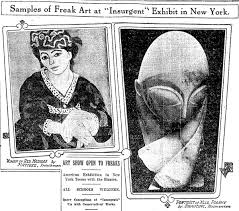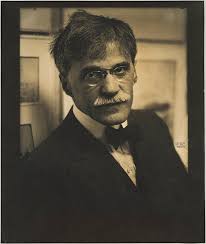Walk: No
Distance: A few blocks
Late in 1906 an artist named Pamela Coleman Smith  came into the Little Galleries and asked Stieglitz to look at some of her drawings and watercolors. Just twenty-eight years old to Stieglitz's forty-two, she was relatively unknown when they met. While there is no record of a relationship between them, Stieglitz was undoubted affected by the combination of her youth, her exotic appearance and her unusual art.
came into the Little Galleries and asked Stieglitz to look at some of her drawings and watercolors. Just twenty-eight years old to Stieglitz's forty-two, she was relatively unknown when they met. While there is no record of a relationship between them, Stieglitz was undoubted affected by the combination of her youth, her exotic appearance and her unusual art. . He decided to show her work because he thought it would be "highly instructive to compare drawings and photographs in order to judge photography's possibilities and limitations". Her show opened in January, 1907, and to Stieglitz's delight it attracted far more visitors to the gallery than any of the previous photography shows. Within a short time nearly every one of her works was sold. Stieglitz, hoping to capitalize on the popularity of the show, took photographs of her art work and issued a separate portfolio of his platinum prints of her work. The success of her show marked a turning point between the old era of Stieglitz as revolutionary promoter of photography and new era of Stieglitz as revolutionary promoter of modern art....
. He decided to show her work because he thought it would be "highly instructive to compare drawings and photographs in order to judge photography's possibilities and limitations". Her show opened in January, 1907, and to Stieglitz's delight it attracted far more visitors to the gallery than any of the previous photography shows. Within a short time nearly every one of her works was sold. Stieglitz, hoping to capitalize on the popularity of the show, took photographs of her art work and issued a separate portfolio of his platinum prints of her work. The success of her show marked a turning point between the old era of Stieglitz as revolutionary promoter of photography and new era of Stieglitz as revolutionary promoter of modern art....
...Then, just after he presented a groundbreaking show of Auguste Rodin's drawings, his own financial problems forced him to close the Little Galleries for a brief period. He reopened the gallery in February 1908 under the new name "291"...
his own financial problems forced him to close the Little Galleries for a brief period. He reopened the gallery in February 1908 under the new name "291"... The name change represented a clear break from the old way of thinking about photography and especially about the Photo-Secession, and from then on the gallery broke down all boundaries between traditional art (paintings, sculptures and drawings) and photography. Stieglitz deliberately interspersed exhibitions of what he knew would be controversial art, such as Rodin's sexually explicit drawings, with what Steichen called "understandable art" and with photographs. The intention was to "set up a dialogue that would enable 291 visitors to see, discuss and ponder the differences and similarities between artists of all ranks and types: between painters, draftsmen, sculptors and photographers; between European and American artists; between older or more established figures and younger, newer practitioners."]......
The name change represented a clear break from the old way of thinking about photography and especially about the Photo-Secession, and from then on the gallery broke down all boundaries between traditional art (paintings, sculptures and drawings) and photography. Stieglitz deliberately interspersed exhibitions of what he knew would be controversial art, such as Rodin's sexually explicit drawings, with what Steichen called "understandable art" and with photographs. The intention was to "set up a dialogue that would enable 291 visitors to see, discuss and ponder the differences and similarities between artists of all ranks and types: between painters, draftsmen, sculptors and photographers; between European and American artists; between older or more established figures and younger, newer practitioners."]......
In February 1913 the watershed Armory Show opened in New York, and soon modern art was a major topic of discussion throughout the city. Stieglitz took great satisfaction in the public's response, although much of it was not favorable,  but he saw the popularity of the show as a vindication of the work that he had been sponsoring at 291 for the past five years. Ever the promoter and provocateur, he quickly mounted an exhibition of his own photographs at 291 to run while the Armory Show was in place. He later wrote that allowing people to see both photographs and modern paintings at the same time "afforded the best opportunity to the student and public for a clearer understanding of the place and purpose of the two media."......
but he saw the popularity of the show as a vindication of the work that he had been sponsoring at 291 for the past five years. Ever the promoter and provocateur, he quickly mounted an exhibition of his own photographs at 291 to run while the Armory Show was in place. He later wrote that allowing people to see both photographs and modern paintings at the same time "afforded the best opportunity to the student and public for a clearer understanding of the place and purpose of the two media."......
...In January 1916, Stieglitz was shown a portfolio of drawings by a young artist named Georgia O'Keeffe. Stieglitz was so taken by her art that without meeting O'Keeffe or even getting her permission to show her works he made plans to exhibit her work at 291. The first that O'Keeffe heard about any of this was from another friend who saw her drawings in the gallery in late May of that year. She finally met Stieglitz after going to 291 and chastising him for showing her work without her permission.[] Stieglitz was immediately attracted to her both physically and artistically. O’Keeffe did not immediately return the interest.
Stieglitz was immediately attracted to her both physically and artistically. O’Keeffe did not immediately return the interest.
*Gratitude to Wikipedia and Google Images




No comments:
Post a Comment